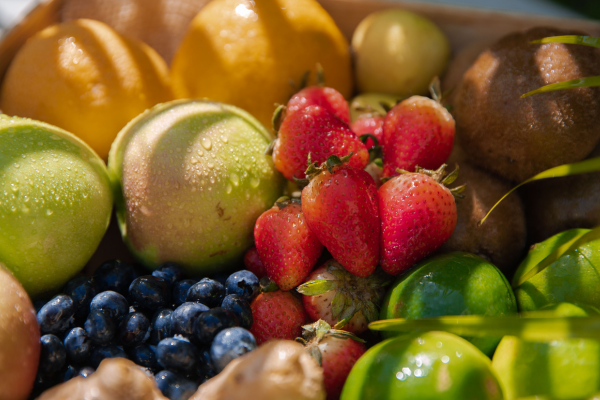Exporting fresh fruit is a rapidly growing opportunity, driven by increasing global demand for tropical produce from Asia, including Indonesia. But this process isn’t as simple as boxing up your goods and shipping them out. Successful fruit export requires strict compliance with international food safety standards, quality control during transport, and an understanding of import regulations in the destination country.
To give you an idea: fruit exports from West Java alone rose from $44.6 million in 2022 to $66.8 million in 2024, showing the trend is gaining traction globally.
However, to take full advantage of this momentum—and sustain it—exporters must be operationally prepared and fully informed. This article explores the top risks in fruit export, how to navigate them, and 5 key steps to exporting fruit safely and efficiently.
🍊 Top Risks in International Fruit Export
While lucrative, fruit export comes with serious challenges—especially for first-time exporters. Here are three common risks to watch out for:
1. Physical Damage or Spoilage in Transit
Fresh fruit is highly perishable. Improper humidity or temperature control can lead to:
- Premature ripening and loss of flavor
- Mold growth or fermentation
- Rotting before the shipment arrives
2. Rejection by Customs Authorities
Each country has strict food safety requirements. Common red flags include:
- Pesticide residue over 0.01 ppm
- Missing GAP, HACCP, or ISO 22000 certifications
- Incorrect or incomplete labeling (especially missing food-grade logos or translations)
Example: In a well-known case, the U.S. rejected 15 mango shipments from India due to missing irradiation documentation. The fruit had to be destroyed, resulting in major losses.
3. Packaging That Doesn’t Meet International Standards
Standard cardboard boxes are prone to moisture damage, especially during long sea freight (7–14 days). This can trigger spoilage and contamination.
The fix? Use water-resistant, laminated PP Corrugated packaging like ALVAboard, which is:
- Moisture-resistant (95%+ RH)
- Lightweight yet strong
- Customizable and certified food-grade
✅ 5 Steps to Export Fresh Fruit Safely
Here’s how to avoid common mistakes and ensure your fruit shipments arrive fresh and compliant:
1. Choose Long-Lasting Fruit Varieties
Focus on produce with longer shelf lives, such as:
- Salak (snake fruit) – lasts up to 3 weeks
- Green mangoes – up to 2 weeks
- Bananas – with controlled ripening
Avoid thin-skinned fruits like strawberries unless shipping under strict cold chain control.
2. Prepare All Required Certifications
Most countries require documentation like:
- GAP (Good Agricultural Practices)
- HACCP (Hazard Analysis and Critical Control Points)
- Phytosanitary Certificate, commercial invoice, packing list, etc.
You can verify your documents via the Indonesia National Single Window (INSW).
3. Maintain a Reliable Cold Chain
According to the ASEAN Postharvest Technology Center (2023), ideal storage temperatures are:
- Tropical fruit (banana, papaya): 12–15°C
- Thick-skinned fruit (mango, pineapple): 8–12°C
- Soft fruit (strawberry, grapes): 0–4°C
Use reefer containers and monitor temps throughout the journey.
4. Use Moisture-Resistant, Food-Grade Packaging
Avoid traditional cardboard. Opt for PP Corrugated laminated packaging, such as ALVAboard, which offers:
- 95% humidity resistance
- High compression strength (10–15 kg)
- Certified food-grade material
It’s already trusted by many exporters across Southeast Asia.
5. Work With Experienced Export Logistics Providers
Choose freight forwarders that specialize in perishables and offer:
- Cold chain container services
- Real-time shipment tracking
- End-to-end export documentation support
❌ Common Mistakes to Avoid in Fruit Export
Avoid these errors to ensure your fruit export isn’t rejected—or worse, spoiled:
1. Using Standard Cardboard Boxes
Cardboard quickly deteriorates in sea humidity. Use PP Corrugated laminated boxes for durability.
2. No Ventilation in Packaging
Fruit needs airflow. Without proper ventilation, humidity builds up and accelerates spoilage.
3. Not Monitoring Temperature & Humidity
Temperature control is critical. Use data loggers or sensors to monitor during transport.
4. Ignoring Food Safety Regulations
Stay current with destination country rules:
- USDA (USA): Requires full traceability and sanitation standards
- EU Regulation 852/2004: Demands HACCP-compliant hygiene practices
Violations can lead to product destruction, re-exportation, or costly fines.
🧊 Keep Fruit Fresh with ALVAboard’s PP Corrugated Packaging!
One of the best ways to preserve fruit freshness and meet export requirements is by using ALVAboard’s laminated PP Corrugated packaging, which offers:
- Moisture and pressure resistance for long-distance shipping
- Certified food-grade safety, ideal for export
- Lightweight and durable, optimized for air and sea freight
- Reusable and eco-conscious, reducing long-term costs and waste
📦 Ready to Upgrade Your Export Packaging?
Contact ALVAboard Customer Service via WhatsApp at +62 877-9310-2838 for a free consultation on the right packaging solutions for your business.
📘 Download our FREE guide:
“Food Export Packaging Made Easy – Strategies for 2025”
🛒 Explore our product range on Tokopedia, Shopee, TikTok Shop, or ALVAboard Shop by searching “ALVAboard.”



